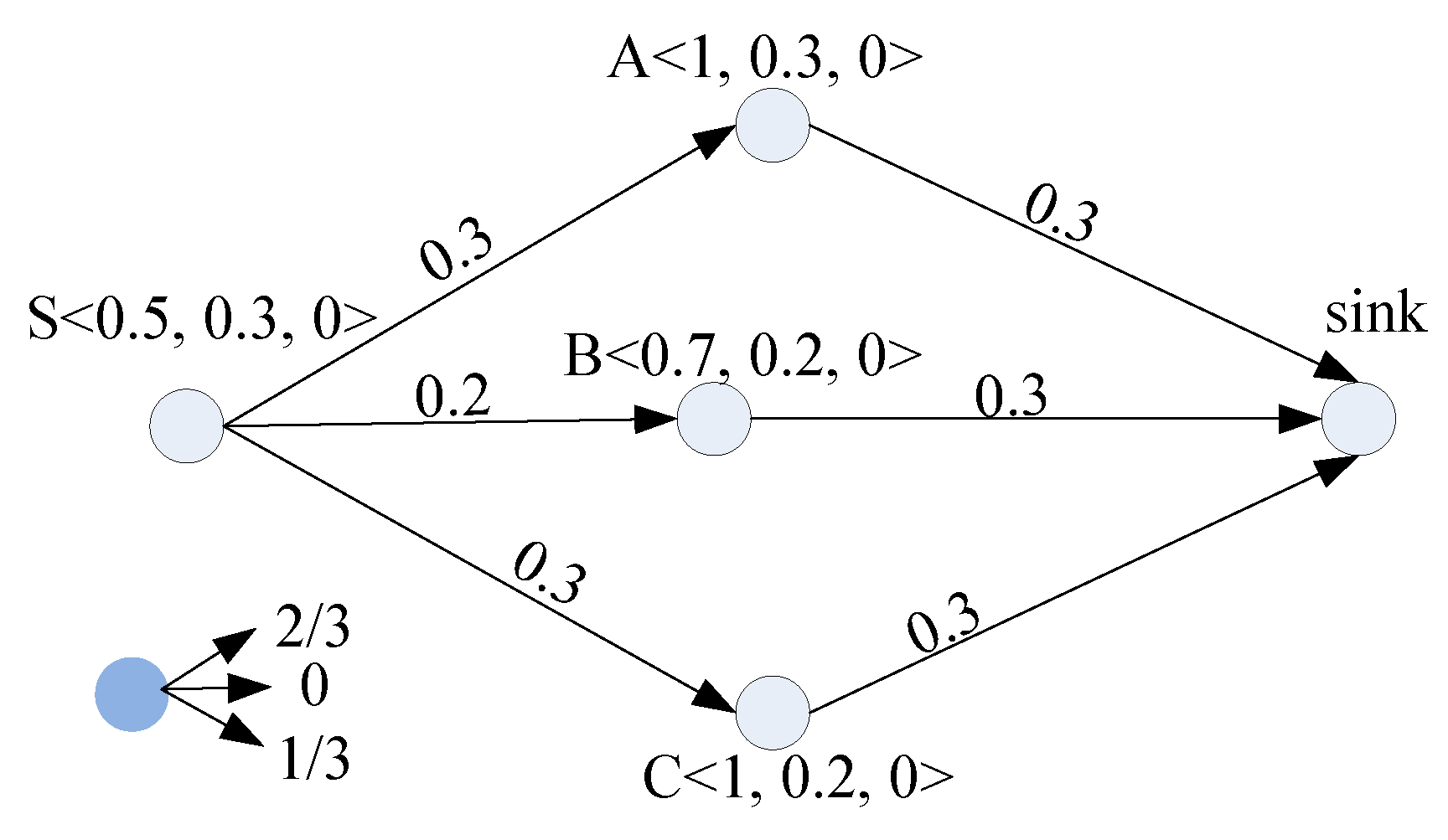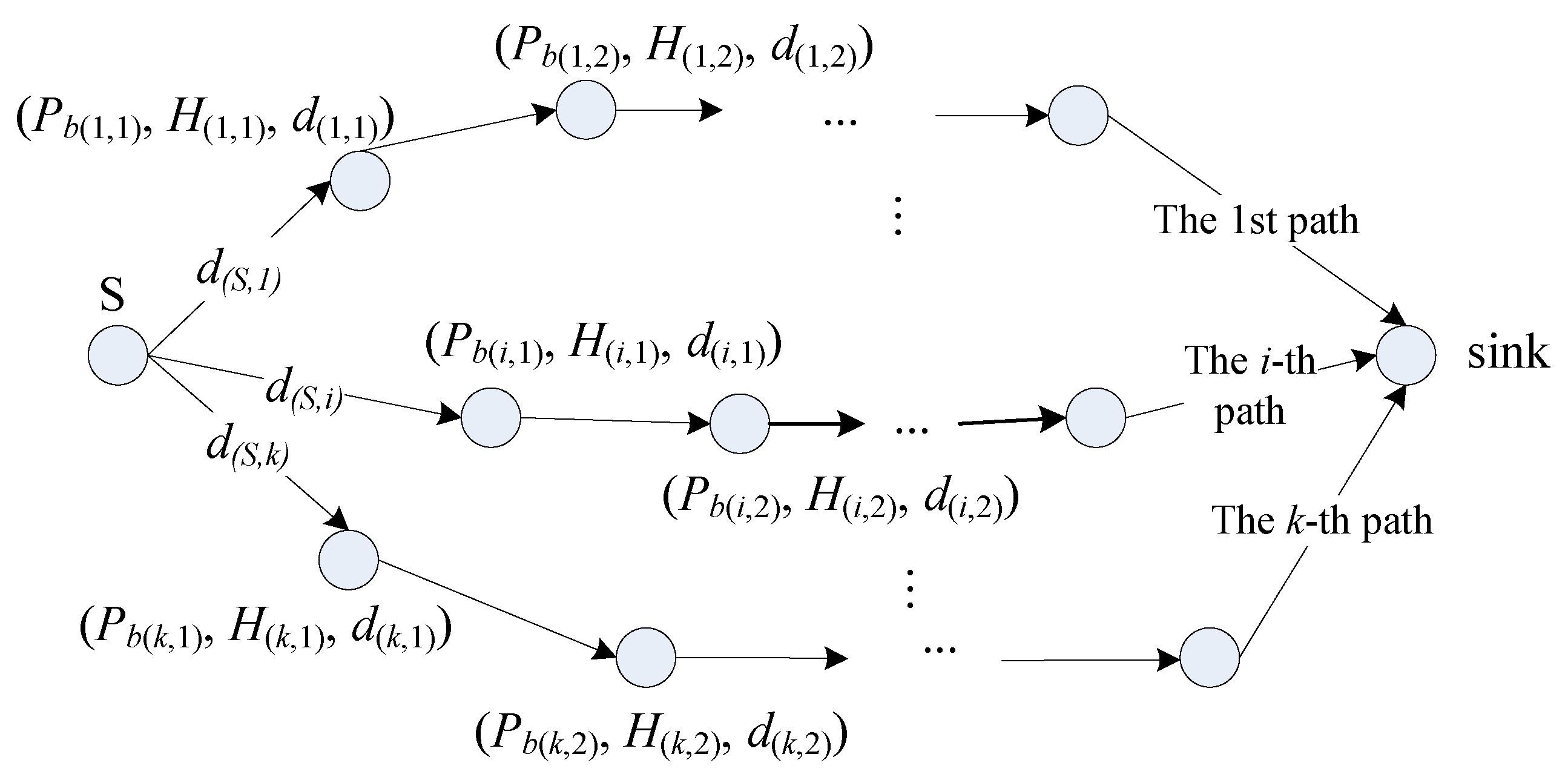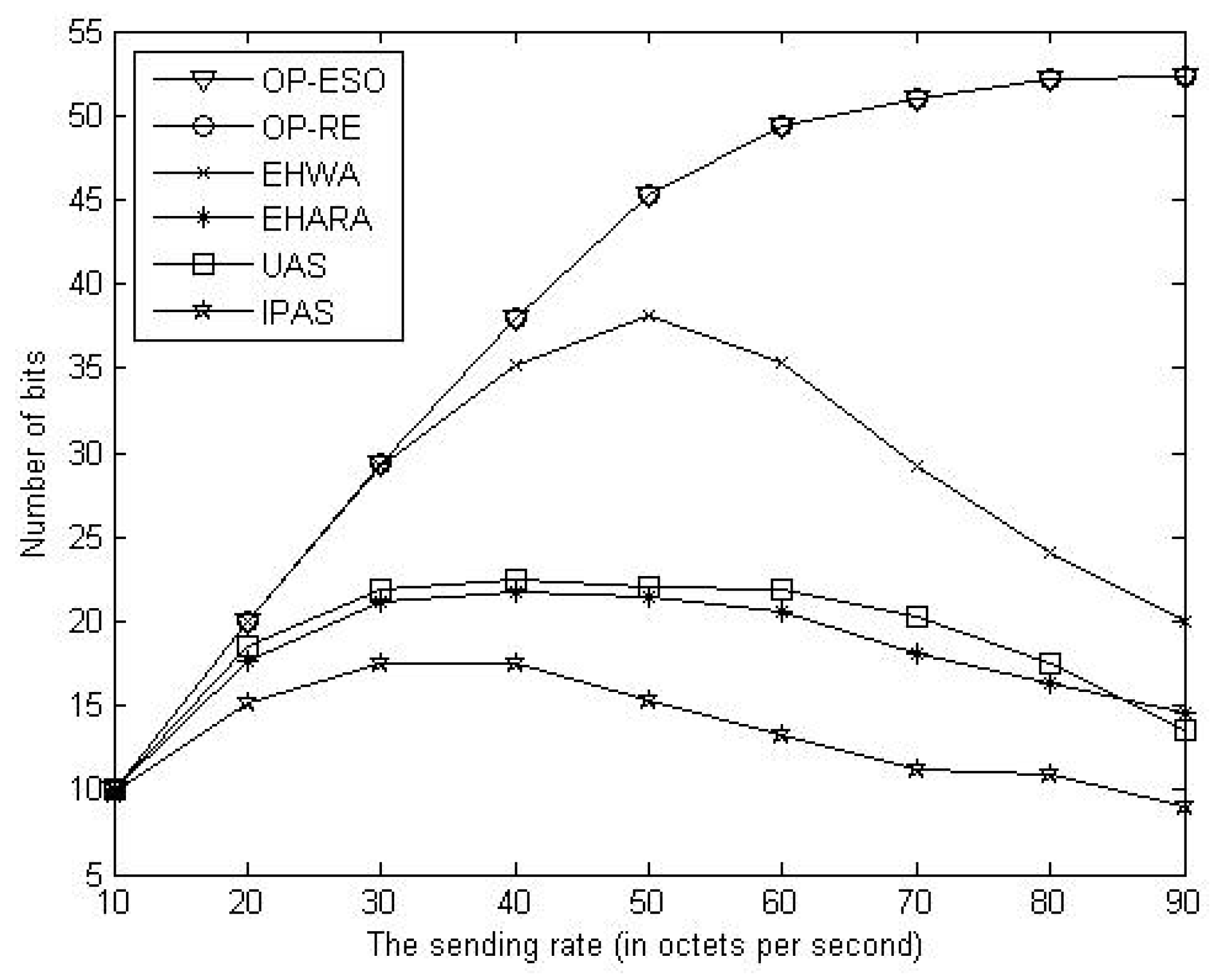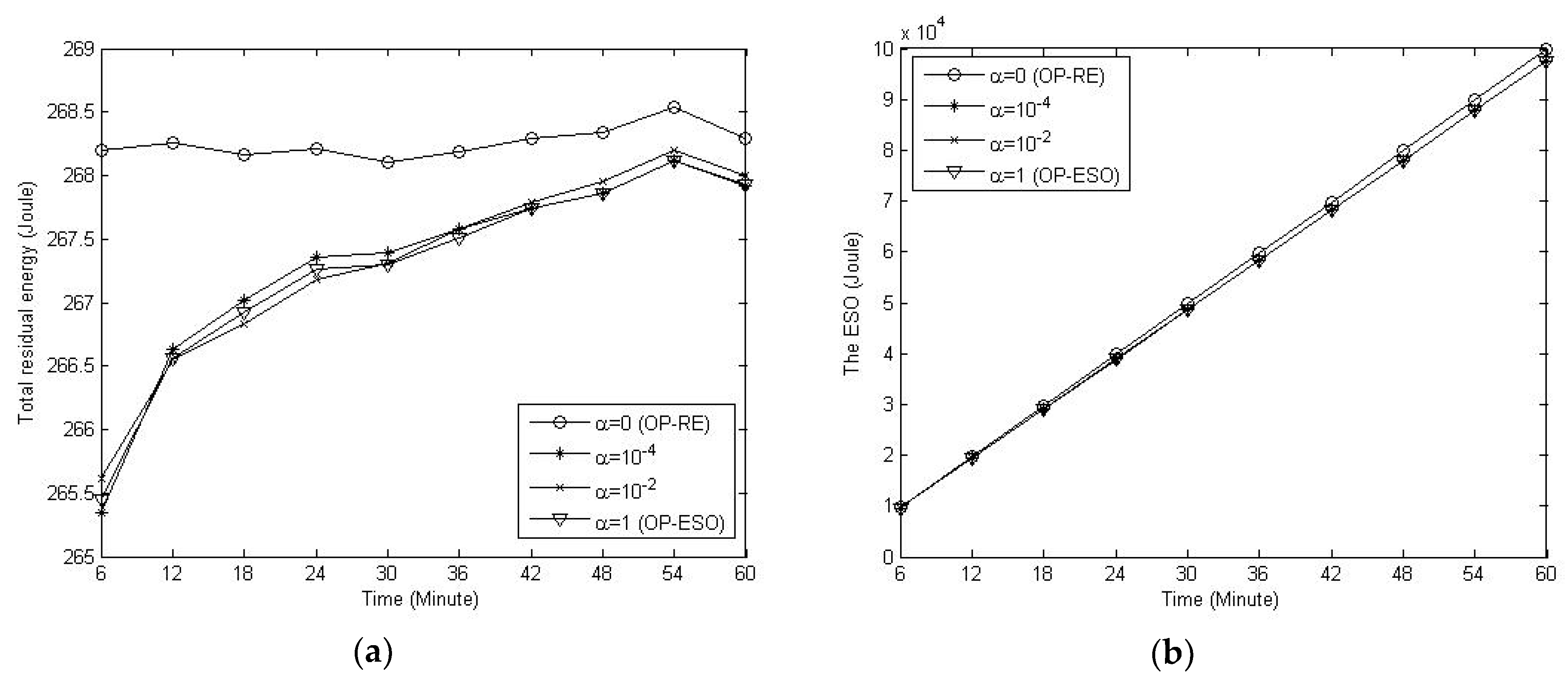Energy Storage Overflow-Aware Data Delivery Scheme for Energy Harvesting Wireless Sensor Networks
Abstract
1. Introduction
2. Related Work
3. ESO-Aware Data Delivering Scheme
3.1. An Example of Alleviating ESO
3.2. The EAMP
3.3. Solution of the Optimization Problem
4. Performance Evaluation
4.1. Simulation Enviroment
4.2. Simulation Results
5. Conclusions
Author Contributions
Funding
Conflicts of Interest
References
- Sudevalayam, S.; Kulkarni, P. Energy Harvesting Sensor Nodes: Survey and Implications. IEEE Commun. Surv. Tutor. 2011, 13, 443–461. [Google Scholar] [CrossRef]
- Zhu, Y.H.; Qiu, S.; Chi, K.; Fang, Y. Latency Aware IPv6 Packet Delivery Scheme over IEEE 802.15.4 based Battery-Free Wireless Sensor Networks. IEEE Trans. Mob. Comput. 2017, 16, 1691–1704. [Google Scholar] [CrossRef]
- Zhu, Y.H.; Li, E.; Chi, K. Encoding scheme to reduce energy consumption of delivering data in radio frequency powered battery-free wireless sensor networks. IEEE Trans. Veh. Technol. 2018, 67, 3085–3097. [Google Scholar] [CrossRef]
- Ateniese, G.; Bianchi, G.; Capossele, A.T.; Petrioli, C.; Spenza, D. Low-Cost Standard Signatures for Energy-Harvesting Wireless Sensor Networks. Embed. Comput. Syst. 2017, 16, 64. [Google Scholar] [CrossRef]
- Dall’Ora, R.; Raza, U.; Brunelli, D.; Picco, G.P. SensEH: From simulation to deployment of energy harvesting wireless sensor networks. In Proceedings of the 39th Annual IEEE Conference on Local Computer Networks Workshops, Edmonton, AB, Canada, 8–11 September 2014. [Google Scholar]
- Zhang, Y.; He, S.; Chen, J. Data gathering optimization by dynamic sensing and routing in rechargeable sensor networks. IEEE/ACM Trans. Netw. 2016, 24, 1632–1646. [Google Scholar] [CrossRef]
- Lin, L.; Shroff, N.B.; Srikant, R. Asymptotically Optimal Energy-aware Routing for Multihop Wireless Networks with Renewable Energy Sources. IEEE/ACM Trans. Netw. 2007, 15, 1021–1034. [Google Scholar] [CrossRef]
- Eu, Z.A.; Tan, H.P.; Seah, W.K.G. Opportunistic Routing in Wireless Sensor Networks Powered by Ambient Energy Harvesting. Comput. Netw. 2010, 54, 2943–2966. [Google Scholar] [CrossRef]
- Lien, C.M.; Lee, S.Y.; Ho, T.Y. Information Dissemination with Epidemic Routing in Energy Harvesting Wireless Sensor Networks. In Proceedings of the IEEE International Conference on Communications (ICC), Sydney, Australia, 10–14 June 2014. [Google Scholar]
- Wang, C.; Guo, S.; Yang, Y. An optimization framework for mobile data collection in energy-harvesting wireless sensor networks. IEEE Trans. Mob. Comput. 2016, 15, 2969–2986. [Google Scholar] [CrossRef]
- Ren, X.; Liang, W.; Xu, W. Data Collection Maximization in Renewable Sensor Networks via Time-Slot Scheduling. IEEE Trans. Comput. 2015, 64, 1870–1883. [Google Scholar] [CrossRef]
- Liu, R.S.; Fan, K.W.; Zheng, Z.; Sinha, P. Perpetual and Fair Data Collection for Environmental Energy Harvesting Sensor Networks. IEEE/ACM Trans. Netw. 2011, 19, 947–960. [Google Scholar] [CrossRef]
- Misra, S.; Majd, N.E.; Huang, H. Approximation Algorithms for Constrained Relay Node Placement in Energy Harvesting Wireless Sensor Networks. IEEE Trans. Comput. 2014, 63, 2933–2947. [Google Scholar] [CrossRef]
- Cristiano, T.; Osvaldo, S.; Michele, R. Dynamic Compression-Transmission for Energy-Harvesting Multihop Networks with Correlated Sources. IEEE/ACM Trans. Netw. 2014, 22, 1729–1741. [Google Scholar]
- Nguyen, T.D.; Khan, J.Y.; Ngo, D.T. An effective energy-harvesting-aware routing algorithm for WSN-based IoT applications. In Proceedings of the IEEE International Conference on Communications, Paris, France, 21–25 May 2017. [Google Scholar]
- Fang, W.; Zhao, X.; An, Y.; Liu, Q. Optimal scheduling for energy harvesting mobile sensing devices. Comput. Commun. 2016, 75, 62–70. [Google Scholar] [CrossRef]
- Son, P.N.; Duy, T.T. Performance analysis of underlay cooperative cognitive full-duplex networks with energy-harvesting relay. Comput. Commun. 2018, 122, 9–19. [Google Scholar]
- Ozel, O.; Yang, J.; Ulukus, S. Optimal transmission schemes for parallel and fading Gaussian broadcast channels with an energy harvesting rechargeable transmitter. Comput. Commun. 2013, 36, 1360–1372. [Google Scholar] [CrossRef]
- Brunelli, D.; Caione, C. Sparse recovery optimization in wireless sensor networks with a sub-Nyquist sampling rate. Sensors 2015, 15, 16654–16673. [Google Scholar] [CrossRef] [PubMed]
- Martinez, G.; Li, S.; Zhou, C. Wastage-Aware Routing in Energy-Harvesting Wireless Sensor Networks. IEEE Sens. J. 2014, 14, 2964–2974. [Google Scholar] [CrossRef]
- Martinez, G.; Li, S.; Zhou, C. Maximum Residual Energy Routing in Wastage-Aware Energy Harvesting Wireless Sensor Networks. In Proceedings of the IEEE 79th Vehicular Technology Conference (VTC Spring), Seoul, Korea, 18–21 May 2014. [Google Scholar]
- Heinzelman, W.B.; Chandrakasan, A.P.; Balakrishnan, H. An Application-Specific Protocol Architecture for Wireless Microsensor Networks. IEEE Trans. Wirel. Commun. 2002, 1, 660–670. [Google Scholar] [CrossRef]
- Holland, J.H. Adaptation in Natural and Artificial Systems; MIT Press: Cambridge, MA, USA, 1992. [Google Scholar]
- Gorlatova, M.; Wallwater, A.; Zussman, G. Networking low-power energy harvesting devices: Measurements and algorithms. IEEE Trans. Mob. Comput. 2013, 12, 1853–1865. [Google Scholar] [CrossRef]
- Lee, S.J.; Gerla, M. Split Multipath Routing with Maximally Disjoint Paths in Ad hoc Networks. In Proceedings of the IEEE International Conference on Communications, Helsinki, Finland, 11–14 June 2001. [Google Scholar]
- National Solar Radiation Database. Available online: http://rredc.nrel.gov/solar/old_data/nsrdb/1991-2010 (accessed on 9 July 2018).









| Notation | Definition |
|---|---|
| Ri | The set of the nodes on the i-th path |
| |Ri| | The number of the elements in Ri |
| (i, j) | The j-th node on the i-th path |
| Pb(i,j) | Residual energy before data delivery for (i, j) |
| Pa(i,j) | Residual energy after data delivery for (i, j) |
| H(i,j) | Incoming energy during the period of data delivery for (i, j) |
| d(i,j) | The distance between nodes (i, j) and (i, j + 1) |
| S | The source node |
| u | The minimum transmission unit |
| B | The energy storage capacity |
| Energy consumption in digital coding, modulation, filtering, and spreading of the signal, etc. | |
| Energy consumption of the transmitter power amplifier | |
| γ | Path loss exponent |
| M | The number of chromosomes in a population in GA |
| Notation | Definition | Value |
|---|---|---|
| u | The minimum transmission unit | one octet |
| B | The energy storage capacity | 5 Joule |
| Energy consumption in digital coding, modulation, filtering, and spreading of the signal, etc | 50 nJ/bit [20] | |
| Energy consumption of the transmitter power amplifier | 10 pJ/bit/m2 [20] | |
| γ | Path loss exponent | 2 |
| M | The number of chromosomes in a population in GA | 400 |
© 2019 by the authors. Licensee MDPI, Basel, Switzerland. This article is an open access article distributed under the terms and conditions of the Creative Commons Attribution (CC BY) license (http://creativecommons.org/licenses/by/4.0/).
Share and Cite
Lu, W.; Zhu, Y.-h.; Chi, K. Energy Storage Overflow-Aware Data Delivery Scheme for Energy Harvesting Wireless Sensor Networks. Sensors 2019, 19, 1383. https://doi.org/10.3390/s19061383
Lu W, Zhu Y-h, Chi K. Energy Storage Overflow-Aware Data Delivery Scheme for Energy Harvesting Wireless Sensor Networks. Sensors. 2019; 19(6):1383. https://doi.org/10.3390/s19061383
Chicago/Turabian StyleLu, Wenwei, Yi-hua Zhu, and Kaikai Chi. 2019. "Energy Storage Overflow-Aware Data Delivery Scheme for Energy Harvesting Wireless Sensor Networks" Sensors 19, no. 6: 1383. https://doi.org/10.3390/s19061383
APA StyleLu, W., Zhu, Y.-h., & Chi, K. (2019). Energy Storage Overflow-Aware Data Delivery Scheme for Energy Harvesting Wireless Sensor Networks. Sensors, 19(6), 1383. https://doi.org/10.3390/s19061383





